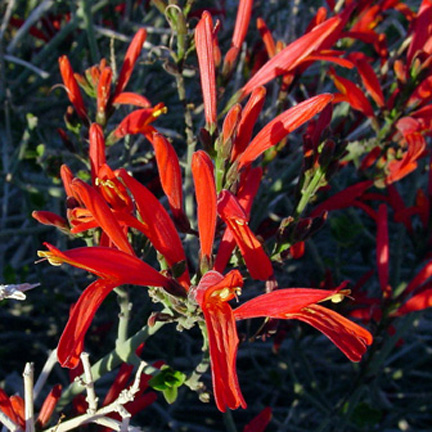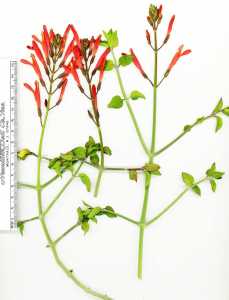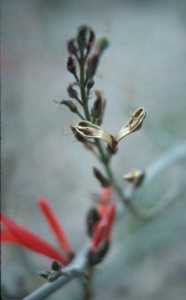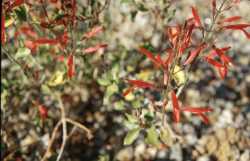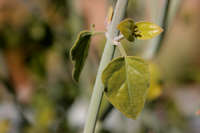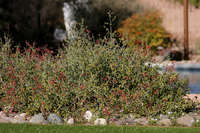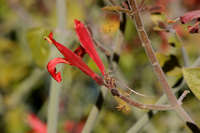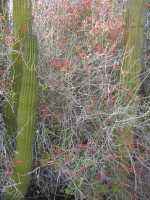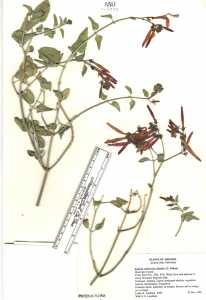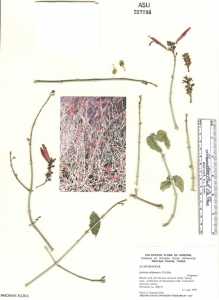|
|
|
|
Family: Acanthaceae
beloperone
[Beloperone californica Benth.] |
General: Small shrub to 2 m, generally leafless, or, when leaves are present, leaves fairly sparse, especially around the inflorescence. Stems and leaves pubescent with fine, short, white hairs, which give the stems a white appearance. The hairs are not easily visible to the naked eye. Leaves: Leaves ovate to lanceolate, bright green, simple, entire, opposite, and with noticeable venation on the underside of the leaf, to 2 cm long. Flowers: Flowers bright red, orange, or occasionally yellow, with an elongated corolla tube, lobes divided with a large lower lip, lower lip having 3 lobes, the upper lip with 2 lobes. Throat occasionally spotted or streaked with yellow. Sepals subulate and tapering. Stamens 2, the anthers having a hard, white, pointed tip. Fruits: An elongated, club-shaped capsule 1.5-2 cm, canescent, with an inflated tip. Seeds 4, rounded, mottled. Ecology: Found in dry, sandy, soils, in washes and canyons below 2,500 ft (762 m); flowers March-June. Notes: Once the plant has flowered and dropped its leaves and capsules, look for the gray (darkening to brown in winter) pubescent stems and star-shaped sepal remnants to help identify this plant. Differentiate from J. candicans by looking at the anthers; J. californica has a short, hard, white basal point on it’s lower anthers, this is absent on J. candicans. Also, the stems of J. californica are obscured by the dense pubescence, while J. candicans is pubescent, its stem is still visible. Ethnobotany: The flowers were sucked for their nectar. Etymology: Justicia is named after after James Justice (1698-1763), a Scottish botanist and horticulturist, son of Sir James Justice. He was apparently the first person to successfully bring a pineapple to the fruiting stage in Scotland, became involved in the tulip bulb craze and died bankrupt, while californica means of or from California. Sources: Benson and Darrow 1981, Hickman 1993, Powell 1988 Benson and Darrow 1981, Hickman 1993, Powell 1988, Kearny and Peebles 1979 Duration: Perennial Nativity: Native Lifeform: Shrub General: Small shrub to 2 m, generally leafless, or, when leaves are present, leaves fairly sparse, especially around the inflorescence. Stems and leaves pubescent with fine, short, white hairs, which give the stems a white appearance. The hairs are not easily visible to the naked eye. Leaves: Leaves ovate to lanceolate, bright green, simple, entire, opposite, and with noticeable venation on the underside of the leaf, to 2 cm long. Flowers: Flowers bright red, orange, or occasionally yellow, with an elongated corolla tube, lobes divided with a large lower lip, lower lip having 3 lobes, the upper lip with 2 lobes. Throat occasionally spotted or streaked with yellow. Sepals subulate and tapering. Stamens 2, the anthers having a hard, white, pointed tip. Fruits: An elongated, club-shaped capsule 1.5-2 cm, canescent, with an inflated tip. Seeds 4, rounded, mottled. Ecology: Found in dry, sandy, soils, in washes and canyons below 2,500 ft (762 m); flowers March-June. Distribution: s AZ, se CA; south to nw MEX Notes: Once the plant has flowered and dropped its leaves and capsules, look for the gray (darkening to brown in winter) pubescent stems and star-shaped sepal remnants to help identify this plant. Differentiate from J. candicans by looking at the anthers; J. californica has a short, hard, white basal point on it's lower anthers, this is absent on J. candicans. Also, the stems of J. californica are obscured by the dense pubescence, while J. candicans is pubescent, its stem is still visible. Ethnobotany: The flowers were sucked for their nectar. Etymology: Justicia is named after after James Justice (1698-1763), a Scottish botanist and horticulturist, son of Sir James Justice. He was apparently the first person to successfully bring a pineapple to the fruiting stage in Scotland, became involved in the tulip bulb craze and died bankrupt, while californica means of or from California. Synonyms: Beloperone californica, Jacobinia californica, Sericographis californica Editor: LCrumbacher, 2011 |
|
|
|


